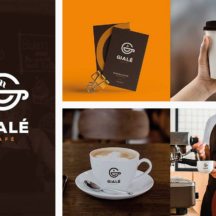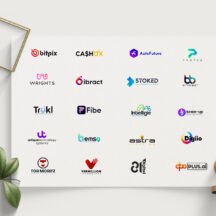How to nail your branding | A guide by brand designer, Jodie McGuinness
Everyone wants their business to have the best brand in their industry. But how do you make your brand unique? It’s not as simple as hiring a logo designer for £100 and hoping this provides you with a complete brand that will make you stand out amongst your competitors. We spoke to brand identity specialist, Jodie McGuiness to find out everything you need to do to smash your branding.
“People are looking for things that are transformative, not just necessarily disruptive.”

What is the difference between a logo and a brand?
When I’m trying to describe to someone the difference between a logo design and a full-scale branding project, I like to use this metaphor. A logo is like polishing the bonnet of the car, you just need something quick and you want to get it out there. Whereas branding is everything under the bonnet so that the car not only looks good, but it also works just well due to things that you can’t necessarily see. It goes deeper so that the outcome is then spread across every single touchpoint that you use for your business.
Branding tells a story of who you are and what you’re about. It’s an entire story about your business and what you want to say to it. Branding is about using visuals as a signpost for what your business stands for so that your potential users and customers can find you.
Top branding offers on PeoplePerHour
Why are brand guidelines important?
Brand guidelines are important for consistency. You may need to pass your branding elements on to other suppliers at some point, and this enables the supplier to stay in line with how your brand should be presented. For example, you might employ someone to do your social media marketing, or you may need someone to work on packaging, your brand guidelines ensure that everything remains consistent across your branding, no matter who is working on it.
Brand guidelines include everything from the colours, fonts and tone of voice that you want your brand to convey, and ensure that these elements don’t get lost. Design can be misinterpreted or subjective to different people, so your brand guidelines are like an anchor for your business.
What should be included in a branding brief?
Before a client approaches me about branding, I would ask them to consider why they need a full branding project, what their long-term goals are, and to research the type of brand they’d like to be.
Think about what your competitors are doing, look into keywords that you want your brand to convey, and delve deep into where your branding is going to be used. The more information I have about your business or vision, the better.
6 steps to creating an awesome brand
One of the first things I ask clients is, have they worked with a brand designer before? If the answer is no, I take them through the whole creative process of how I work.
- I send every client a discovery questionnaire, which I build into a deck based on their answers.
- Once I’ve got all the information I need, I create a visual mood board based on their feedback, to build the style that they want to create.
- I start to sketch for the logo. I usually send my logo options over in black and white as colour is very subjective.
- When they’ve chosen one, I build a colour palette based on the mood board and the keywords they want to convey about their business.
- I put those logo designs into mock-ups to visualise those ideas in different formats such as business cards and advertising boards.
- Adding colour. I approach the use of colour based on the personality of the brand that the client wants. For example, if they want to convey a corporate, trustworthy brand, then I’m going to lean towards blues and darker colours or colours that instil trust in people. If they want a more playful brand, say, if it’s aimed at children, then the colours are going to be bright, poppy and vibrant.
What are the best tools for staying on top of branding trends?
There are a few sites I use. One is called Abduzeedo, which is great because it pulls in designs from all over the world. I also use Behance, as it’s one of the biggest design websites in the world. Something less obvious that I find really useful is mainstream stock imagery sites because they give you a marker of what people are downloading. When you’re a designer, you want to go down a unique route, so checking these sites acts as a good marker for your own design and it’s a good place to see what trends are coming up as well.
Top tips for creating a unique and effective brand
Think about exactly what you want to convey. Check out what your competitors are doing and aim to do something different to them. Carry out proper research into who your target market is and what they would connect with. People want realness over something that just looks cool.
For our interview with Jodie, check out our full video.

















